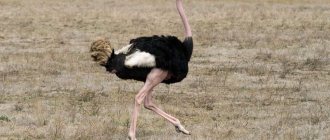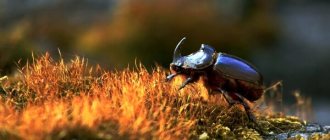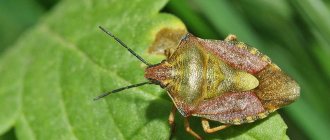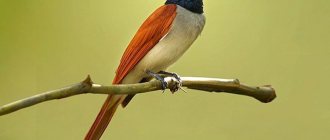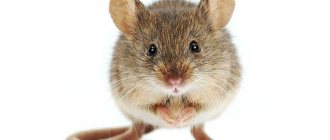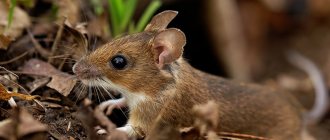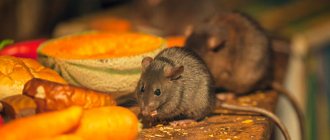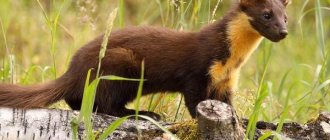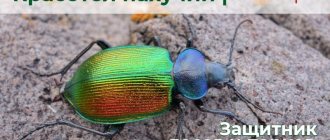The African ostrich (lat. Struthio camelus) is the largest bird in the world and the only representative of the order Ostrichidae, the ostrich family, genus Ostrich. Belongs to the class of birds, subclass ratites.
The international scientific name is Struthio camelus Linnaeus, 1758.
Protected status – causing the least concern.
The biological name of the flightless bird, translated from Greek, literally sounds like “camel sparrow” (Greek στρουθίο-κάμηλος). Such an apt allegory arose due to the characteristic features of the ostrich: it has the same expressive eyes as a camel, framed by long eyelashes, two-fingered limbs and a chest callus. The comparison with a sparrow probably arose due to its small, poorly developed wings.
Ostrich - description, structure, characteristics, photo. What does an ostrich look like?
The African ostrich is a bird unique in nature, which cannot fly, has no keel and has only two toes, which is also an exception in the class of birds.
Being the largest birds on the planet, large specimens of the African ostrich boast a height of 2.7 meters and an impressive weight of up to 156 kg. However, the average weight of an ostrich is about 50 kg, with males being slightly larger than females.
The ostrich skeleton is not pneumatic, with the exception of the femur. The ends of the pubic bones fused together and formed a closed pelvis, which is also uncharacteristic of other birds.
Photo credit: Museum of Veterinary Anatomy FMVZ USP / Wagner Souza e Silva
African ostriches are distinguished by a dense build, a very elongated neck and a small, flattened head, ending in an even, wide, flat beak, on which there is a soft growth of horny tissue.
The ostrich has large eyes, and the upper eyelid is dotted with long, fluffy eyelashes.
Photo by: Vvlasenko
Photo by: Donarreiskoffer
The outgrowth of the sternum, or keel, characteristic of representatives of the class of birds, is completely absent in ostriches, and the sternum itself is poorly developed.
On its surface there is a bare area of thick skin - a special breast callus that acts as a support when the bird lies on the ground.
Photo by: Diego Delso
The forelimbs of the bird are represented by underdeveloped wings, each of them has two fingers ending in sharp claws.
The hind legs of the ostrich are long, strong and muscular, with two toes, and only one of them has a kind of hoof at the end, which serves as a support while running.
Photo credit: Yathin S Krishnappa
Photo by: Skampetsky
The ostrich's plumage is loose and curly, relatively evenly distributed over the surface of the body. There are no feathers on the head, neck and legs: they are covered with soft, short down.
Ostrich feathers have a primitive structure: their barbs practically do not adhere to each other and do not form a fan. Birds have very beautiful feathers and there are quite a lot of them: 16 flight feathers of the first order and from 20 to 23 of the second order, tail feathers can be from 50 to 60.
Photo credit: Essdras M Suarez/EMS Photography
Photo by: Bob-Nan
It is very easy to distinguish a male ostrich from a female. The plumage of adult males is black, and only the tail and wings are white.
The females are quite inconspicuous: their feathers are distinguished by a protective grayish-brown color, and their wings and tail plumage look off-white.
Photo by: Vladimir Motyčka
What does an ostrich eat?
The ostrich is an omnivorous bird, and although the diet of young individuals consists mainly of animal food, adult birds feed on all kinds of vegetation. Their diet consists of grasses, shoots and seeds of plants, flowers, ovaries, as well as fruits, including quite hard ones. However, adult individuals are far from vegetarians and, if possible, will not refuse various insects, for example, locusts, as well as lizards, small rodents and carrion in the form of uneaten prey of large predators. Ostriches have nothing to chew food with, so to improve digestion they eat sand and small pebbles, and often various inedible objects: wood chips, pieces of plastic, metal and even nails. Ostriches can also easily fast for several days.
Like camels, ostriches are able to do without water for a long time: they only need the liquid from the green mass of plants they consume. But, having access to water, the ostrich drinks a lot and willingly. Ostriches bathe with just as much pleasure.
Where do ostriches live? Ostrich lifestyle
Ostriches live in Africa. Birds avoid tropical rainforests, preferring open grassy landscapes and semi-deserts located north and south of equatorial forests.
The habitat of ostriches on the African continent. The places where different subspecies of the African ostrich live are highlighted in color. Photo by: Renato Caniatti
African ostriches live in family groups consisting of a mature male, 4-5 females and their offspring. Often the size of a flock reaches 20-30 individuals, and young ostriches in the south of their range live in groups of up to hundreds of birds.
Often ostriches share pastures with entire herds of antelopes or zebras, while animals and birds treat each other quite peacefully and travel together across the African savannas. Possessing tall stature and excellent eyesight, ostriches immediately notice the approach of predators and quickly run away, taking steps up to 3.5-4 m long. In this case, the speed of an ostrich can reach about 60-70 km/h. Long-legged runners are able to quickly change direction without slowing down. And ostrich chicks, 30 days old, are practically as good as their parents and can run at speeds of up to 50 km/h.
Photo by: KuK
Raising chicks
Raising ostrich chicks photo
Dimensions
Newborn ostrich chicks are about 20 cm in height. They grow at a rate of about 1 cm per day to a value of 150 cm.
Feeding
For the first three days, it is recommended not to feed or drink babies so that their gall sac resolves. The ambient temperature is maintained at 32-33°C. On the fourth day, the ostrich chicks are given a mixture of crushed clover or alfalfa leaves with mixed feed (as for broiler chickens) and water. At the same time, they begin to give cottage cheese and boiled eggs. At the 5th week of life and up to 3 months, the chicks are fed with compound feed, as for broiler chickens. Be sure to place separate feeders with gravel or small stones. Young ostrich chicks switch to grass food in the summer, eat root vegetables (potatoes, carrots, beets) in the fall, and eat silage in the winter.
Types of ostriches, photos and names
During the Pleistocene and Pliocene eras, there were several varieties of ostriches on earth, living in Western and Central Asia, India and the southern regions of Eastern Europe. The chronicles of the ancient Greek historian Xenophon mention these birds that inhabited the desert landscapes of the Middle East, west of the Euphrates River.
The uncontrolled extermination of birds has led to a sharp decline in the population, and today the only species of ostriches includes 4 surviving subspecies living in the vastness of Africa. Below is a description of the subspecies of the African ostrich.
- Common or North African ostrich (Struthio camelus camelus)
Distinguished by a bald spot on the head. This is the largest subspecies, whose height reaches 2.74 meters, while the ostrich weighs up to 156 kg. The limbs and neck of the ostrich are painted an intense red color, and the shells of the eggs are covered with thin rays of pores, forming a pattern similar to a star. Previously, common ostriches lived over a large area covering the north and west of the African continent, from Ethiopia and Uganda in the south of their range to Algeria and Egypt in the north, covering West African countries including Mauritania and Senegal. Nowadays, the habitat of these birds has been significantly reduced, and now the common ostrich lives only in a few African countries: Cameroon, Chad, the Central African Republic and Senegal.
Common ostrich (North African ostrich) male (lat. Struthio camelus camelus). Photo by: MathKnight
Female common ostrich (lat. Struthio camelus camelus). Author of the photo: שלומי שטרית
- Masai ostrich (Struthio camelus massaicus)
Inhabitant of East Africa (southern Kenya, eastern Tanzania, Ethiopia, southern Somalia). Its neck and limbs turn an intense red color during the breeding season. Outside the breeding season they are pink.
Male Masai ostrich (lat. Struthio camelus massaicus). Photo by: Nicor
Female Masai ostrich (lat. Struthio camelus massaicus). Photo by: Nevit Dilmen
- Somali ostrich (Struthio camelus molybdophanes)
Based on mitochondrial DNA analysis, it is sometimes considered a separate species. Males have the same bald patches on their heads as members of the common ostrich subspecies, but their necks and limbs are distinguished by a bluish-gray skin color, and female Somali ostriches have especially bright brown feathers. Somali ostriches live in southern Ethiopia, northeastern Kenya and Somalia, and the local population calls them the beautiful word “gorayo”. This subspecies of ostriches prefers to live in pairs or alone.
Photo by: David Bygott
- Southern ostrich (Struthio camelus australis)
It is also distinguished by the gray color of the plumage of the neck and limbs, and its range is limited to the southwestern part of Africa. The ostrich is found in Namibia, Zambia, Zimbabwe, Angola and Botswana, and lives south of the Zambezi and Kunene rivers.
Male southern ostrich (lat. Struthio camelus australis). Photo by: Bernard DUPONT
Female southern ostrich (lat. Struthio camelus australis). Photo credit: Yathin S Krishnappa
Productivity
Historically, ostriches of different species have been useful in different ways - for example, the feathers of the African ostrich were in great demand in the production of various jewelry, and the shells of their eggs could well be used as a goblet among some African peoples. In addition, "Africans" could be used for harnessing horse-drawn vehicles and even riding horses, and emu fat was for some time considered a valuable medicine. But today there is a certain demand for the skin of both types of birds, but its truly widespread use can only be considered in those countries where there are many ostrich farms, and these are perhaps South Africa and Australia. In all other countries, the main reason for breeding these large birds today is meat and eggs.
Despite the fact that African ostriches and emus have not been considered biologically related for several decades, their meat is quite similar. Experienced gourmets claim that it is reminiscent of beef, but at the same time it is even less fatty, which in times of widespread popularity of healthy eating may be of interest to many consumers. Emu meat, whose fat content does not exceed 1.5%, should be considered especially lean.
Ostrich eggs are not the main product of this branch of poultry farming, if only for the reason that females do not lay them very often, but the size of such an egg can impress anyone. If we talk about the African subspecies, its egg is an impressive 15-21 cm long and weighs a good 1.5-2 kilograms, which is equivalent to about 25-36 average chicken eggs
Against this background, it is no longer so important how many eggs one female lays per year - there will definitely be a demand for them. The volume of a clutch in the wild can range from 15 to 60 eggs, but here you need to take into account that several females “belonging” to one male make a common clutch
Farmers have calculated that at home, a young ostrich produces 20-25 eggs per year, while an experienced female 6-7 years old can lay up to 70 eggs annually.
Emus, as birds of more modest size, have egg dimensions that are also not so impressive. The number of eggs from one female in a clutch can range from 7-8 to 20 eggs, their average weight is approximately 700-900 grams. As is the case with their African counterparts, in one emu nest the “products” of several females can be collected at once, directly related to the same male.
Among other things, African ostrich feathers have not yet completely gone out of fashion - they can still be sold profitably. At the same time, the bird is not inclined to lose elements of its plumage, and you should not try to tear them out either - instead, the feathers are carefully cut off close to the skin. To harvest such a “harvest,” it is necessary to wait until the bird is at least 2-3 years old—feathers among young people are considered useless.
Ostrich breeding
Ostriches reach puberty at the age of 2-4 years. During the mating period, each male vigilantly guards his personal territory within a radius of 2 to 15 square kilometers and mercilessly drives out competitors. The neck and limbs of the displaying male become bright red, and to attract females, he falls to his knees, intensively beats his wings, arches his neck back and rubs the back of his head against his back. During competition for possession of a female, males make very original trumpeting and hissing sounds. Having collected more air into its crop, the male ostrich sharply pushes it into the esophagus, announcing the surroundings with something like a uterine roar, reminiscent of the roar of a lion.
Ostriches are polygamous, so the dominant male mates with all the females in the harem, but mates exclusively with the dominant female for subsequent incubation.
After mating, the future father personally digs a nest in the sand up to 30-60 cm deep, where all fertilized females periodically lay eggs, performing a similar manipulation once every two days.
Photo by: Alina Zienowicz
Among all the bird variety, the ostrich has the largest eggs, although, in relation to the body, they are quite small. On average, the size of an ostrich egg is between 15 and 21 cm in length and about 13 cm in width. The weight of the egg reaches 1.5-2 kg, which is equivalent to 25-35 chicken eggs. The thickness of the shell is approximately 0.6 mm, and its color is straw-yellow, sometimes darker or, conversely, lighter.
In eggs laid by different females, the texture of the shell varies and can be glossy and shiny or matte and porous.
Photo by: Raul654
Ostrich egg compared to chicken and quail eggs. Photo by: Rainer Zenz
In the inhabitants of the northern part of the range, a joint clutch, as a rule, contains from 15 to 20 eggs, in the south - about 30, in the East African population the number of eggs in a nest often reaches 50-60. After laying eggs, the dominant female ostrich forces her competitors to leave and rolls her eggs into the middle of the hole, identifying them by the texture of the shell.
The incubation period lasts from 35 to 45 days, only the male incubates the clutch at night, and the females take turns watching during the day. This choice is not accidental: thanks to their protective coloration, the females remain unnoticed against the backdrop of the desert landscape. During the day, the masonry is sometimes left unattended and warmed by the heat of the sun. Despite the general care of the parents, many clutches die due to insufficient incubation. In populations where there are too many females, the number of eggs in a clutch may be such that the male is physically unable to cover all the offspring with his body.
An hour before birth, the ostrich chick begins to open the shell of the egg, rests its splayed legs against its sharp and blunt ends and methodically hammers its beak into one point until a small hole is formed. Thus, the chick makes several holes, and then hits this place with force with the back of its head, so ostrich chicks are often born with significant bruises that tend to disappear quickly. When the last chick is born, the adult ostrich mercilessly destroys the non-viable eggs lying on the edge, and immediately the flies gather for a feast, serving as food for the chicks.
Photo by: Pries
Newborn ostrich chicks are sighted, well developed, their bodies are covered with light fluff, and their weight is about 1.2 kg. The chicks that are born move well and the next day they leave the nest, going with their parents in search of food. For the first two months, ostrich chicks are covered with black and yellow bristles, the crown is brick-colored, and the neck is off-white with dark longitudinal stripes.
Only over time do they develop real feathers, and the outfit of all chicks becomes similar in color to the plumage of females. Male ostrich chicks acquire the black color characteristic of adults only in the second year of life.
Taken from: www.reddit.com
Ostrich chicks are very attached to each other and if two groups of chicks meet, it is impossible to separate them, which is why flocks consisting of ostrich chicks of different ages are often found in the savannas of Africa.
Being polygamous birds, the male and female start a fight with each other, and the stronger parent gets further care of the brood.
Photo by: Magnus Manske
From the history…
It is believed that ostriches appeared on the planet 12 million years ago. And the trade in the feathers of these animals dates back to the early Egyptian civilizations and goes back three thousand years. In some countries, even before the beginning of our era, animals were kept in captivity. In Ancient Egypt, noble ladies rode ostriches to festive ceremonies. Animal feathers became in great demand at the beginning of the nineteenth century, which led to a significant reduction in the number of birds. In the middle of the century, a period of rapid development of ostrich farming began. The first farm in Africa appeared in 1838. Animals were bred solely for the purpose of obtaining valuable feathers. For example, in South Africa at that time, the export of feathers was in fourth place after the export of gold, wool and diamonds.
Gradually, ostriches began to be bred in captivity in other countries and on other continents: in the USA, Algeria, Egypt, Australia, Italy, Argentina, New Zealand. But during the period of two world wars, this type of business almost ceased to exist, and the number of farms decreased significantly.
Enemies of ostriches in nature
Ostrich eggs are hunted by jackals, hyenas and scavenger birds. For example, a vulture grabs a large stone with its beak and throws it on top of an egg several times until it cracks. Chicks can also be attacked by lions, cheetahs, leopards or hyenas.
It is in vain to think that ostriches are timid birds: in fact, they are quite aggressive and are able to fend for themselves and their offspring. An angry ostrich, without hesitation, will attack a person who has encroached on its territory, and even seasoned predators are afraid of adult birds. Cases have been recorded when a defending ostrich mortally wounded an adult lion with one powerful kick.
Photo by: Kevin Power
Birds similar to the African ostrich
There are several species of birds that are very similar to the ostrich. But they do not belong to the ostrich family and genus Ostrich. Below is a brief description of them.
Darwin's rhea, also known as the small rhea or long-billed rhea (Rhea pennata)
A flightless bird of large size from the rhea order, the rhea family, the genus rhea. The plumage of the bird is gray or grayish-brown, with white spots on the back. The height at the back is approximately 90 cm, weight varies between 15-25 kg. Darwin's rhea lives in southern Argentina, including Patagonia and the southern Andes, Bolivia, Argentina and the island of Tierra del Fuego.
Photo by: CHUCAO
Greater rhea, common rhea , also known as northern rhea (Rhea americana)
A flightless bird from the rhea order, rhea family, rhea genus. A typical representative of South America. It lives in Argentina and Bolivia, in Brazil, Paraguay and Uruguay. The height of a large rhea to the level of the crown reaches 127-140 cm, weight varies from 20 to 25 kilograms or more. The color of the feathers is brownish-gray; often among birds there are albino individuals with white plumage and bright blue eyes.
Photo by: Rufus46
The cassowary (Casuarius) is a large bird that is unable to fly. Belongs to the order Cassowary, family Cassowary, genus Cassowary. Scientists have identified three types of cassowaries. Individuals reach 150 cm in height and weigh up to 80 kg.
A distinctive feature of the bird is a kind of helmet-like growth on its head. The head and neck of the bird are usually unfeathered, the color of the feathers on the body is black, and two species have bright “earrings” of different colors in the neck area. Cassowaries live in the tropical thickets of New Guinea, in the northeast of Australia, and are found on the islands of Aru, Muruk, Salavati, and Yapen.
Photo by: Michael Schmid
Emu (Dromaius novaehollandiae)
A large flightless bird from the order Cassowaries, the emu family, the genus emu. It reaches a height of 150-170 cm, weighing from 45 to 55 kg. The color of the feathers is gray-brown. Emu is widespread throughout almost all of Australia.
Photo by: Benjamint444
Ostrich meat
African ostrich meat is a fairly healthy product, which, according to some nutritionists, has surpassed even the popular turkey in terms of minimal cholesterol content and maximum protein. Ostrich meat has a dark red color, tastes a little like veal, cooks very quickly, but with prolonged heat treatment it can lose tenderness and juiciness. Ostrich meat is highly valued in Asian and European countries, becoming quite a common restaurant dish among connoisseurs of delicious food with exotic notes. Ostrich meat is used to prepare delicious steaks, roasts, cold appetizers, cutlets; it is boiled, stewed and baked. Lean meat of the African ostrich contains manganese, potassium and iron, it is rich in phosphorus, B vitamins and nicotinic acid.
Is it possible to breed it?
The ostrich is a large and exotic bird, but hardy and omnivorous. In order for a bird to live comfortably on a farm, the following conditions must be met:
- there should be a spacious grassy area nearby on which various plants will grow;
- the presence of an insulated poultry house, since ostriches love warm climatic conditions, even despite their endurance;
- For one male you need to keep 3-4 females, this ensures their proper reproduction.
It is important to handle birds carefully and carefully, because they can behave very aggressively during mating periods, protecting their chicks and eggs.
You can learn about breeding African ostriches in the video:
Do ostriches bury their heads in the sand?
There is a misconception that ostriches bury their heads in the sand, but they do nothing of the sort. The appearance of this myth was facilitated by the manner of birds standing with their heads bowed to the ground and swallowing small pebbles that promote digestion.
An ostrich can also drop its head on the sand after a long run. The bird has no strength left, and thus it rests.
Taken from: theiwrc.org
Lifestyle
Ostriches prefer to be in a mutually beneficial community with zebras and antelopes, so following such animals, flightless birds easily migrate. Thanks to good eyesight and fairly large growth, representatives of all subspecies of ostriches are the very first to notice natural enemies, and very quickly give a signal of approaching danger to other animals.
Frightened representatives of the Ostrich family scream loudly and are capable of running at speeds of up to 65-70 km or even more. At the same time, the step length of an adult bird is 4.0 m. Small ostrich chicks, already at the age of one month, easily reach speeds of up to 45-50 km per hour, without reducing it even during sharp turns.
Outside the mating season, African ostriches tend to stay in fairly small flocks or so-called “families”, consisting of one adult male, several chicks and four or five females.
The widely held belief that when very frightened, ostriches bury their heads in the sand is erroneous. In reality, the large bird simply lowers its head to the ground to ingest gravel or sand to aid its digestive process.
Ostriches are active mainly at dusk, and in too much midday heat and at night, such birds most often rest. Night sleep of representatives of the African ostrich subspecies includes short periods of deep sleep, during which the birds lie on the ground and stretch their necks, as well as long periods of so-called half-asleep, accompanied by a sitting posture with eyes closed and neck raised high.
Hibernation
African ostriches are able to perfectly withstand the winter period in the central zone of our country, which is due to their rather lush plumage and innate excellent health. When kept in captivity, special insulated poultry houses are built for such birds, and the young animals born in winter are more hardened and stronger than birds raised in the summer.
Interesting facts about ostriches
- Ostrich feathers are particularly beautiful and are traditionally used for fans, fans and headdress decorations. The popularity of ostrich feathers led to the fact that if in the 19th century only a ton of raw materials were exported from Africa per year, then at the beginning of the 20th century this figure was already 370 tons.
- In the mid-19th century, birds began to be kept on farms, and if this had not happened, the ostrich population might not have survived to this day. Today, more than 50 countries have ostrich breeding farms, including countries with cool climates, in particular Sweden. In addition to preserving the species, the main purpose of breeding ostriches is to obtain expensive leather, feathers and tasty meat reminiscent of beef.
- The feathers of ostriches that have reached the age of 2-3 years are not plucked out, but are carefully cut off near the skin, repeating the procedure 2 times a year.
- Since ancient times, people have used ostriches as a means of transportation: the birds were harnessed to a sled, and they were also ridden on horseback.
- An ostrich fleeing from pursuit often performs the following trick: the bird falls on the sand and stretches its neck, giving the pursuers the impression that the ostrich has suddenly disappeared. But when they approach the hidden bird, the rested ostrich jumps up in the blink of an eye and quickly disappears into the distance.
- An interesting feature of ostriches is that they swallow completely inedible things. A number of interesting objects were found in the stomach of one ostrich: 3.5 kg of sand, rags, tow, 3 pieces of iron, 9 coins, a copper hinge, 2 iron keys and even lead bullets.
- You can ride an ostrich. The bird can easily carry an adult on itself.
Author of the photo: メルビル
Did you like the article? Share with your friends:
Natural habitats
Depending on the subspecies, the place of residence of the African ostrich varies. Most often, birds try to find the following natural conditions for life:
- Savannah. Ostriches, due to their natural characteristics and the need to quickly move, prefer grassy savannas and places with few trees. The plain is an excellent place for procreation and nutrition. On flat lands, you can clearly see all the animals nearby, including predators. Therefore, in case of danger, ostriches can flee in advance.
- Semi-desert. Groups of African ostriches can be found there while hatching eggs. However, they do not live in the Sahara Desert. Because it is difficult for birds to run on this kind of sand, which is necessary for them. The best option for life would be a semi-desert with hard soil and small bushes.
There are areas that ostriches try to avoid - these are mainly swampy areas, high impenetrable thickets of grass and trees, deserts with shifting sands.
